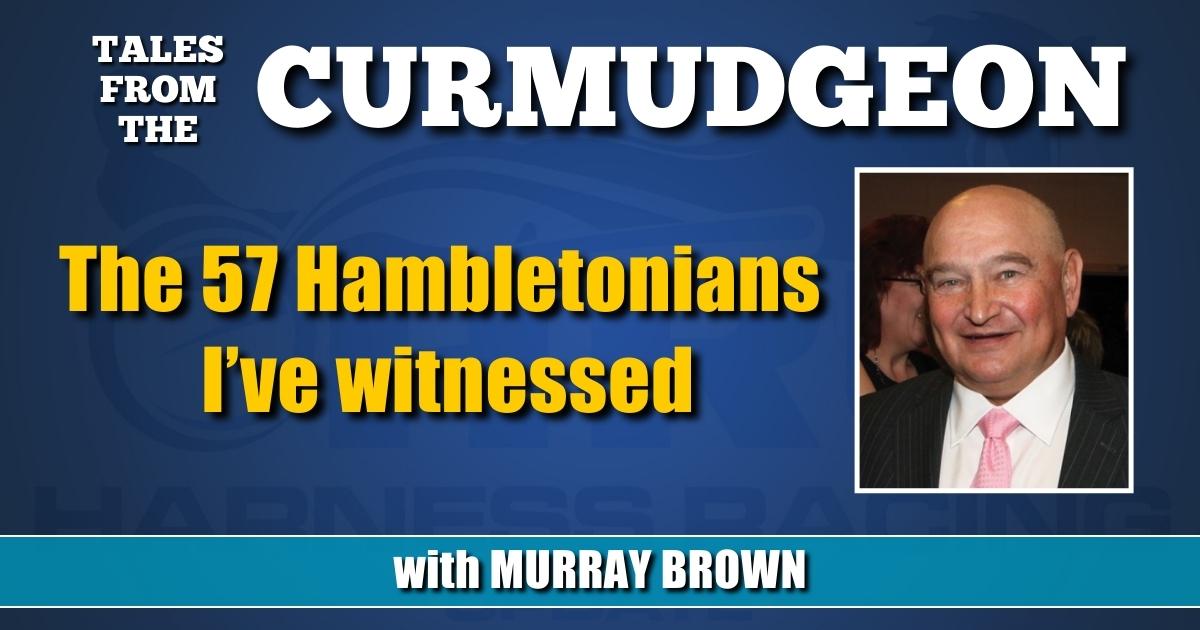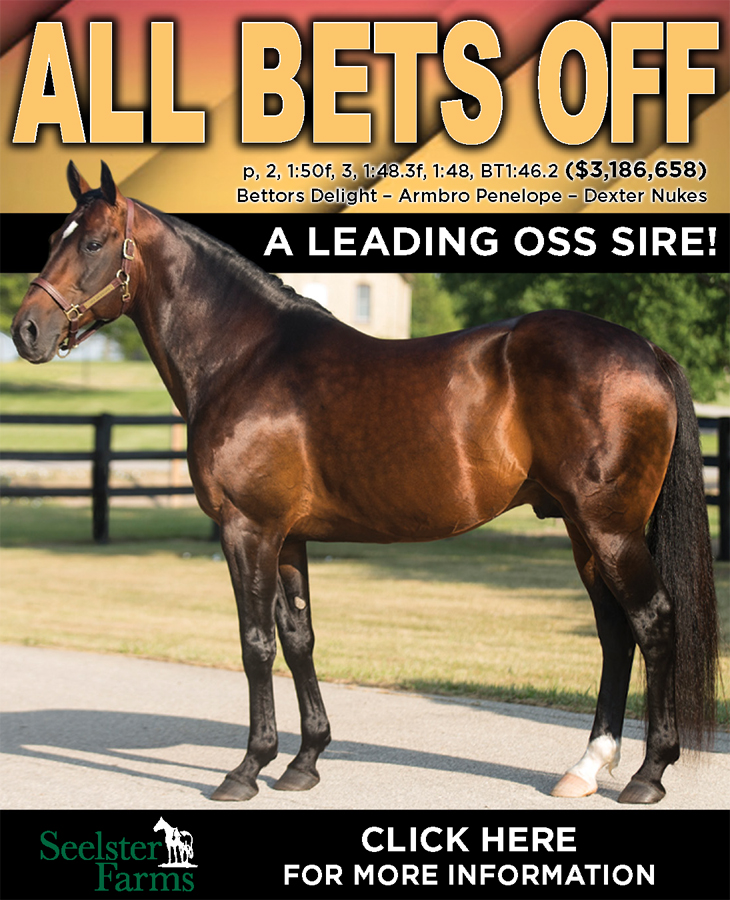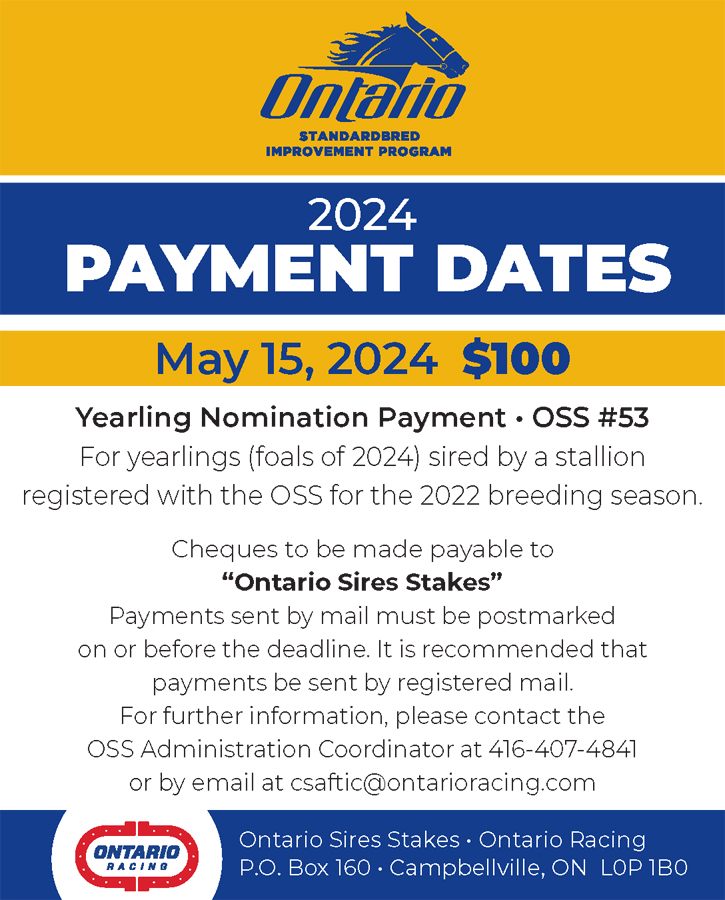

The 57 Hambletonians I’ve witnessed
Part 1 — The DuQuoin years.
by Murray Brown
A friend and I were talking last week. In the course of our conversation, I said that last week’s Hambletonian was going to be my 57th consecutive one. He said ‘That has to be a record. Nobody else has been to that many; certainly not consecutively.’ I told him I knew for a fact that Ebby Gerry had been to more. I’m not sure how many more, but his attendance at the race dated back to Titan Hanover’s win in 1945 at Goshen.
My buddy suggested that my next column should recount the Hambletonians that I’ve been to and perhaps mention anything of interest associated with each. I said I would give it a try, but that it would certainly amount to more data than in a single column, maybe as many as three columns. I’ve divided it so that the first one covers the races that took place in DuQuoin, IL, from 1967 through 1980.The second one covers those at The Meadowlands in the remainder of the 20th century from 1981 through 1999. The third column will go from year 2000 to the present.
I’d be remiss in not mentioning that YouTube aided me a great deal. Most of what I speak of comes from memory, but there are a few areas where YouTube helped with things that I hadn’t remembered or in correcting items about which I was about to err.
1967 — Speedy Streak — Frank Ervin had the favored entry of Speedy Streak and Speed Model in the race, but he was unable to be there. He was a patient in the hospital. He asked his friend Del Cameron to substitute for him behind Speedy Streak. The other half of his entry, the filly Speed Model, was driven to a third-place finish by Ervin’s assistant Arthur Hult.
1968 — Nevele Pride — Even though there was no betting yet at DuQuoin, Nevele Pride was the overwhelming favorite going into the race. He did not disappoint. He virtually jogged on his way to an easy multi-length win. It was the middle win, after the Yonkers Futurity and before the Kentucky Futurity on his route to winning the Triple Crown and Horse of the Year.
1969 — Lindy’s Pride — This one held a significant personal touch for me. Lindy’s Pride, then named Galahad Hanover, was a pupil in my first yearling class at Hanover Shoe Farms. In my opinion, he was our best yearling and I fully expected him to top the sale. Instead, he brought a disappointing $15,000, not bad for a yearling in 1969, but very disappointing for a colt that I was certain was going to lead the sale.
I felt that Clarence Gaines and K.D. Owen were going to buy him, but found out later that Dr. John Steele had advised them not to because he felt the colt’s hocks would not hold up to training and racing. Lindy’s Pride went on to win the Triple Crown and what was then called the Big Five, adding the Vernon Gold Cup and the Colonial to the three Triple Crown races.
1970 — Timothy T. — This one also held a personal touch with me. He was from the first crop of Ayres a horse that I admired and loved. Ayres was one of several stallions that I felt could not miss and then did just that. John Simpson, my boss, had purchased him privately from Minnesota drug store owner John Thro for $10,000. He was small, but so was Ayres. He was athletic and sharp in appearance. His price, although cheap today was slightly below average for the time. In 1968 when the sale took place the Hanover Shoe Farms yearlings averaged $18,205, an almost 50 per cent increase over the previous year’s record of $12,137. This was the first year at Hanover after the farm’s founder Lawrence Sheppard had passed away. The sale of Timothy T. took place before the Harrisburg sale and his price was arrived at using the previous year’s average of $12,137 as a guide. Timothy T. was the favorite in the race. Two days before the race Timothy T. came down with what Simpson referred to as ‘the sniffles.’ I remember him saying that if the race was not the Hambletonian he likely would have scratched. But it was the Hambletonian and he decided to go ahead and race. In my mind’s eye I can see both Simpson Sr. and Jr. rubbing Vick’s VapoRub into Timothy T.’s nostrils with caretaker Charlie Coleman looking on. Timothy T. won the race driven by Simpson Jr., then the youngest driver to ever win the Hambletonian.
1971 — Speedy Crown — Speedy Crown was bred and raised by his trainer and driver Howard Beissinger. He was sold to the members of the Antonacci and Lomangino families. He was to become their second Hambletonian starter and their second winner of America’s Classic Trotting Race. Beissinger raced Speedy Crown lightly at 2. He wasn’t near a star as a freshman. Nobody, except possibly Beissinger, would have guessed at how great a 3-year-old, older trotter and monumental sire he would become. I never asked the question of Beissinger, but I suspect that he didn’t either. If he had, why would he have sold him?
1972 — Super Bowl — ‘Soup’ as he was affectionately known around Hanover was to become my all-time favorite horse, not necessarily because of his ability on the racetrack which was to become exceptional, but more so because of his kind demeanor and unique character in his time at Hanover. He was a lanky, somewhat immature yearling who Stanley Dancer bought for his then wife Rachel for the bargain price of $15,000. He was not held in the highest of esteem by Stanley throughout his early 2-year-old training. All we heard from Stanley all winter and spring was Stars Chip. Stars Chip was a small racy Stars Pride colt that Stanley had bought for Mac Cuddy, the turkey man from Strathroy, ON. As Stanley was wont to do, until he possibly changed his mind, he thought Stars Chip could become a great horse. Super Bowl and Stars Chip were both by Stars Pride, but with many by that great sire, they could not have been more dissimilar. Stars Chip was smallish, but quick and fast. Super Bowl was big and gangly, often disinterested and just plodded along. In the early 2-year-old stakes races at Brandywine, they lived up to their history. Stars Chip won a division of the General George Washington impressively. In his division Super Bowl finished third to Brownie Hanover, a colt that Stanley’s brother Harold won with in 2:10.3. From that point, even through Super Bowl’s Triple Crown wins, Harold wouldn’t recognize that Super Bowl was a top horse. “He couldn’t beat Brownie Hanover, who wasn’t much, in 2:10.3,” was a refrain I heard more than once. It was the soft, big, mid-western mile tracks combined with heats that made a new horse out of Super Bowl. The formerly disinterested colt thrived on sunshine and work. On Hambletonian Day at DuQuoin he defeated a pretty good group of trotters, with Delmonica Hanover finishing second and Spartan Hanover third. Often when I think of Super Bowl, I think of Alan Leavitt and how he could have “owned” harness breeding if he hadn’t quarreled with Stanley over Albatross. He already had Speedy Crown and No Nukes. Speedy Somolli was in the wings. Add Albatross and likely then Super Bowl to his Lana Lobell Farms roster and people might have said Hanover who?
1973 — Flirth — One of four gelding winners in my 57 years. He was a homebred owned by the Arden Homestead Stable. Shortly after the race he was purchased by the later to be convicted murderer John du Pont, who came from the ultra-wealthy Delaware family of the same name. He had been active in thoroughbred racing as well as other sports. Well known Philadelphia sportscaster Jim Leaming, a great guy and true lover of harness racing had horses with Stanley Dancer and wanted to get his friend du Pont involved in our sport. Soon after the purchase things went sour. Flirth didn’t race well and then became lame. Dancer and du Pont didn’t get along. Dancer in effect kicked him out of the stable. Du Pont sued Dancer, I believe claiming that his “lack of ability” caused Flirth to go lame. I believe the case was either dropped or settled out of court.
1974 — Christopher T. — This was the first Hambletonian won by Billy Haughton after ١٦ previous disappointments. In commentary for the race, Stan Bergstein said “the Hambletonian for 3-year-old trotters had escaped and tormented” Haughton. After this race his stable went on to win five more. So, Burke and Gingras, don’t give up! That first one, as well as likely others are out there waiting for you. This particular race is well worth watching on YouTube, since Haughton himself gives commentary while the race is taking place. Christopher T. was the full brother to 1970 Hambletonian winner Timothy T. Breeder John Thro wasn’t about to make the same mistake that he had made with Timothy T. by selling him as a yearling. He kept the colt and entrusted him to Billy Haughton. He was a very good 2-year-old, but had been somewhat disappointing going into the Hambletonian. Nevele Diamond had been the pre-race favorite, and he raced like one in winning the first heat by open lengths for Stanley Dancer. The next heat (different horses) was won by Christopher T., just getting up at the wire. The final was won by Christopher T., while Nevele Diamond was a well beaten favorite fading through the field. One thing quite noticeable was the colors the drivers were wearing. None of them had short sleeves. If you’ve ever been to DuQuoin in late August, you’d know they were needed.
1975 — Bonefish — This was the first time that they had pari-mutuel wagering at DuQuoin. It was a marathon and what a race it was! It went four heats. The first heat went to pre-race favorite Bonefish driven by Stanley Dancer. The second heat went to Yankee Bambino for Walter Ross. The third heat went to Noble Rogue driven by Jimmy Arthur. The final fourth heat, a race off between the three heat winners went to Bonefish, a narrow winner over Yankee Bambino.
1976 — Steve Lobell — This was another four-heat race. It was a race in which tragedy was narrowly avoided, when after having gone four difficult heats, the ultimate race winner Steve Lobell collapsed in his stall and nearly died. The three previous heats were won by Zoot Suit, Steve Lobell and the filly Armbro Regina. The first heat included a ridiculous 18 starters. By the second heat they were down to 14. The third heat still included 12. Here’s an interesting tidbit from this race. Three of the greatest sires to ever stand stud in Sweden — Pershing, Quick Pay and Zoot Suit — were among its contestants.
1977 — Green Speed — According to present USTA rules, Green Speed the winner of the race was a 4-year-old. Green Speed was born in December during one of the few years where the foaling calendar was pushed back to allow for foals of the previous November and December to be registered as yearlings of the following year. Another huge group had 16 starters. Green Speed was a convincing straight two-heat winner for Billy Haughton, with Texas being second both heats, each heat was timed in a world record 1.55.3. By the way, if you watch the YouTube replays of these races, you cannot help but realize how great a race caller Stan Bergstein was.
1978 — Speedy Somolli — If ever three trotting colts were as closely matched as possible, it was probably the trio of Speedy Somolli, Florida Pro and Brisco Hanover. Ultimately Speedy Somolli proved to be the best of the trio but not by much. It seemed that these three colts were almost always close together in all their 2- and 3-year-old races. The thing I remember most about Speedy Somolli is his dam Somolli who previously bore a Hanover name. She could trot faster than any yearling we had that year, or most any other year. We didn’t have a lead pony who could open her up. Howard Beissinger bought her for the account of Robert Mumma. I fully expected her to become a champion, but to my knowledge, she never raced. Beissinger and Mumma had her bred to Speedy Crown and she produced Speedy Somolli; she got the champion, but one generation later.
1979 — Legend Hanover — I can›t tell you much about this horse other than he represented a great deal of energy expended in trying to get Dr. Raymond Galt, a major yearling buyer of the day, to come to Hanover and buy one of our yearlings. Previous to his buying this colt, I believe it was the only Hanover yearling that he had ever bought. I remember him coming to the farm one Saturday afternoon with his then trainer Stanley Dancer. He wanted to buy a Super Bowl colt from us. I’m guessing that we had about 10 of them. He had us line them all up alongside each other. It appeared that he was interested in a few, but he didn’t show up at Harrisburg, nor did he buy a yearling from us. The next year a fellow by the name of Raymond Tripp showed up at the Fairgrounds. He said he was there to look at all the Super Bowl colts for Galt. He apparently liked Legend Hanover. That was the only yearling that Galt had ever bought from Hanover and he won the Hambletonian with him.
Legend Hanover also has a connection to me. In 1968, shortly after my first year at Hanover, the Mirons, for whom I had previously worked in Canada, asked me if there were any of their mares in which Hanover had any interest. There were two Hoot Mon mares, which caught my fancy, one of which was Laurita Hanover. I believe we bought the pair for $25,000 or thereabouts. Laurita Hanover was a very fast filly in her day, having a 2-year-old record of 2:00.1. When we bought her, she previously had five foals, none had done much of consequence. She was in foal to Tie Silk carrying her sixth foal. The next and first Hanover bred foal was the aforementioned Somolli, the dam of Speedy Somolli. She then waited until her twelfth foal before she had her Hambletonian winning son Legend Hanover.
1980 — Burgomeister — This was the most emotionally charged Hambletonian that I›ve ever been to. It was the very last Hambletonian at DuQuoin. The Hayes family of DuQuoin had been great stewards of the race and most were sad to see it leave. Peter Haughton had tragically been killed in a car accident the previous winter. His horse Burgomeister which he owned with restauranter Marcello Fiorentino** was the emotional favorite. There were 19 entered and the field was split. The first heat was won by Final Score driven by 23-year-old Tommy Haughton, Peter’s younger brother. The next heat was won by Burgomeister after a rough trip on the rim. The final and the race was won by Burgomeister. There was nary a dry eye in the place.
**If ever you are looking for a great Italian restaurant, perhaps the very best one in South Florida, try Fiorentino’s La Sirena in West Palm Beach, now owned and run by Marcello Fiorentino Jr. and his wife Diane. You might thank me.














